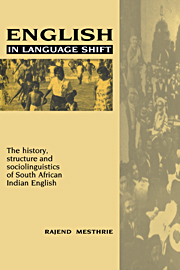 English in Language Shift
English in Language Shift Book contents
- Frontmatter
- Contents
- List of figures and maps
- List of tables
- Preface
- Acknowledgements
- List of abbreviations
- 1 Historical background: the shaping of a New English
- 2 Variation in SAIE: a first glimpse
- 3 Syntactic variation: the relative clause
- 4 Word-order principles
- 5 Non-syntactic variation
- 6 Perspectives from second-language acquisition
- 7 Perspectives from pidgin and creole studies
- Appendix A Comparison between SAIE sample and census data for Indians in Natal
- Appendix B Types of relative clauses used by individual speakers
- Appendix C Rank orders for relative clauses, topics and morphology
- Notes
- Sources and references
- Index
7 - Perspectives from pidgin and creole studies
Published online by Cambridge University Press: 03 December 2009
- Frontmatter
- Contents
- List of figures and maps
- List of tables
- Preface
- Acknowledgements
- List of abbreviations
- 1 Historical background: the shaping of a New English
- 2 Variation in SAIE: a first glimpse
- 3 Syntactic variation: the relative clause
- 4 Word-order principles
- 5 Non-syntactic variation
- 6 Perspectives from second-language acquisition
- 7 Perspectives from pidgin and creole studies
- Appendix A Comparison between SAIE sample and census data for Indians in Natal
- Appendix B Types of relative clauses used by individual speakers
- Appendix C Rank orders for relative clauses, topics and morphology
- Notes
- Sources and references
- Index
Summary
Pidginisation, creolisation, second-language acquisition
Whereas many students of second-language acquisition (for example, Valdman 1980; Andersen 1980) and some psycholinguists (for example, Slobin 1983) have been amenable to viewing it in terms of processes of pidginisation and creolisation, creolists generally have not. Sankoff (1983: 242), for example, has warned that ‘we have about reached the limit of the usefulness of the terms “pidginization” and “creolization’”. While Bickerton (1977a: 49) had once characterised pidginisation as second-language learning with restricted input and creolisation as first-language learning with restricted input, in a subsequent study (1983: 238) he was to paint them as widely divergent processes:
No real connection exists between SLA [Second Language Acquisition] and creolization: they differ in almost every particular. SLA is done alone, creolization is done in groups; SLA has a target, creolization hasn't; SLA is done mainly by adults, creolization mainly by kids … SLA gives you a second language, creolization gives you a first; SLA is done by people with a ‘normal’ language background, creolization with an ‘abnormal’ language background.
Slobin (1983: 252) holds the opposite view:
Wherever language users or language learners are pushed to devise a linguistic means of expression which is lacking or not evident in the language or languages at hand, the only source of materials lies within. These materials consist of prototypical notions of specifiable form and content and preferred ways of mapping those notions onto linguistic expressions, striving for mapping that is maximally transparent and direct – again in specifiable ways.
- Type
- Chapter
- Information
- English in Language ShiftThe History, Structure and Sociolinguistics of South African Indian English, pp. 183 - 221Publisher: Cambridge University PressPrint publication year: 1993


